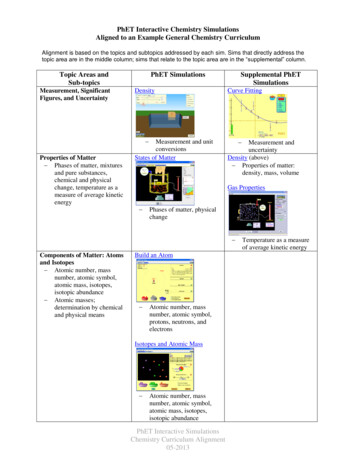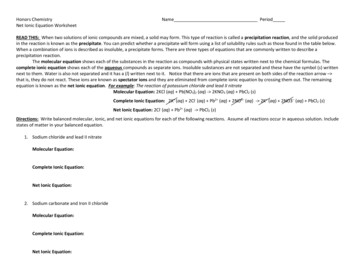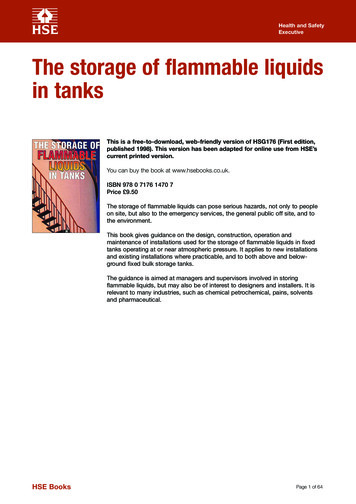
Transcription
14DBU Derived Ionic Liquids and TheirApplication in Organic Synthetic ReactionsXinzhi Chen1 and Anguo Ying21Department2Schoolof Chemical and Biochemical Engineering, Zhejiang University, Hangzhou,of Pharmaceutical and Chemical Engineering, Taizhou University, Taizhou,P.R. China1. IntroductionWith the continuing depletion of natural resources and the growing environmentalawareness, current and future chemists are being trained to develop synthetic routes ineconomically beneficial manner. One strategy to realize these green processes in organicsynthesis is the replacement of toxic volatile organic solvents with environmentally morebenign reaction mediums. Among the novel green solvents that have been reported, ionicliquids (ILs) have been one of the most active areas of green chemistry over the past decade,due to their excellent chemical and thermo properties such as good thermal stability,negligible vapor pressure, ease of handling, potential for recycling, good coordinating anddissolving capability. Thus, ILs were widely used in various organic transformations(Miao& Chan, 2006; Ying et al., 2008; Ying et al., 2008). However, most of the ILs studied bychemists are structurally based on imidazole which is inert for organic reactions. So the needfor the developments of novel task-specific ionic liquids still exists.On the other hand, 0- octakydropyrimido[1,2- ]azep -ine, DBU) was found to be superior to other tertiary amines as catalyst, base orpromoter. For example, using DBU as catalyst for Balylis-Hillman reaction and aza-Michaeladdition was reported by Aggarwal and Kim respectively(Aggarwal & Mereu, 1999; Yeomet al., 2007). DBU-mediated CO2-fixation reaction(Yoshida et al., 2008), DBU-promoted, S-Ntype Smiles and Ireland-Claisen rearrangement reactions(Ma et al., 2007; Li et al., 2007),DBU-catalyzed addition reactions of sulfonylimidates(Matsubara & Kobayashi, 2008), DBUpromoted chemoselective cleavage of acetylenic TMS group(Yeom et al., 2008), and DBUassisted unusual dehydrogenation(Kim et al., 2008) were all found to be very efficient.Considering the special role that DBU played in organic synthesis, ionic liquids with a DBUmoisture (Scheme 1) were developed(Tolstikoua & Shainyan, 2006). Because of its large size,low symmetry of cationic moiety and charge delocalization over the N-C N triad renderthese type of ionic liquids low melting points.However, the salts in Scheme 1 are inert and can only been used as reaction solvents. Then,we attempted to develop a new class of task-specific DBU-derived ionic liquids which couldnot only serve as reaction medium but also as catalyst or promotor. The preparation of thefive novel ILs can be simply realized by neutralization reaction of DBU and thecorresponding carboxyl acids, including acetic acid, lactic acid, propionic acid and butyricacid (Scheme2)(Ying et al., 2009; Ying et al., 2010; Ying, 2010). Among these ILs, [DBU][Tfa]www.intechopen.com
306Ionic Liquids: Applications and PerspectivesRNNXR Me, Et, Bu, PhCH2, H(CF)nCH2;X Cl, Br, OTs, OTf.Scheme 1HNN CH3CH(OH)COOHNDBUCH3CH(OH)COON[DBU][Lac]HNN CF3 COOHNCF3COONDBU[DBU][Tfa]HNN CH3 COOHNCH3COONDBU[DBU][Ac]HNN CH3CH2COOHNCH3 CH2COONDBU[DBU][n-Pr]HNNDBUScheme 2www.intechopen.comN CH3CH2CH2COOHNCH3CH2CH2COO[DBU][n-Bu]
307DBU Derived Ionic Liquids and Their Application in Organic Synthetic Reactionsis liquid with weak acidicity at room temperature, while the other four ionic liquids,[DBU][Ac], [DBU][Lac], [DBU][n-Pr] and [DBU][n-Bu] show property of weak basicity[11].Next, we will investigate the applications of the novel DBU-based ionic liquids in Michaeladdition and Knoevenagel condensation. To improve the recycling capability, ionic liquidsimmobilized on Magnetic nanoparticles (MNP) will also been summarized in this chapter.2. Application in Michael addition2.1 Michael addition (aliphatic amines as Michael donors)Carbon-nitrogen bond forming reaction is one of the most important methodologies insynthetic organic chemistry for preparation of -aminocarbonyl compounds, which not onlyconstitute a component of biologically active natural products but also serve as a keyintermediate for the syntheisis of -aminoalcohols, -lactams and -amino acids(Kleinmann,1991; Georg, 1993; Corey, 1989). Manich reaction between enolates and imines provide aclassic route for the construction of -amino carbonyl compounds(Arend et al., 1998;Kobayashi & Ishitani, 1999). However, this type of reaction often requires harsh reactionconditions and long reaction time. Compared with the Manich reaction, the aza-Michaeladdition of amines to electron deficient alkenes has attracted considerable attention as analternative protocol for C-N bond formation due to its atomic economy and operationalsimplicity. Most aza-Michael reactions are usually carried out with a strong acid or a base,which would lead to by-products or undesired harmful residues. Thus, milder Lewis acidiccatalysts such as LiClO4(Azizi & Said, 2004), Yb(OTf3)(Jenner, 1995; Matsubara et al., 1994),Bi(NO3)(Srivastava & Banik, 2003), FeCl3.6H2O(Xu et al., 2004), CeCl3.7H2O(Bartoli et al.,2001), InCl3(Loh & Wei, 1998), SmI2(Reboule et al., 2005), Cu(OTf)2(Xu et al., 2005), and so onare employed in the Michael protocol. Recently, some novel reagents used as catalyst orpromoter in conjugate addition have been reported, including -cyclodextrin(Surendra etal., 2006), bromodimethylsulfonium bromide(Khan et al., 2007), boric acid inwater(Chaudhuri et al., 2005), ZrOCl2.8H2O on montmorillonite K10(Hashemi et al., 2006),imidazoliHum-based polymer supported CuI(Alleti et al., 2008), KF/Al2O3(Kantam et al.,2008), [HP(HNCH2CH2)3N]NO3(Yang et al., 2005), etc. However, many of the abovemethods suffered from some drawbacks, such as the requirement for a large excess ofreagents, substrate-selective for some catalysts, and often involvement of some toxicsolvents such as 1,2-dichloroethane or acetonitrile.OOBn2NH O[DBU][X]rtBnNOBnAmong the five ionic liquids, [DBU][Ac] showed slightly higher catalytic activity than theother ionic liquids(Table 1, entry 7 and entries 10-13). For the comparison with DBU aspromoter for aza-Michael addition reported by Kim et al., 50 mol % of the ionic liquid[DBU][Ac] was employed for the model reaction between dibenzylamine and methylacrylate in acetonitrile at room temperature(Yeom et al., 2007). The reaction catalyzed by[DBU][Ac] was slightly faster than that promoted by its parent base DBU (Table 1, entries 12), indicating the rationality of [DBU][Ac] as catalyst for the reaction. Other solvents such asmethanol, toluene, and dichloromethane were also tested and they were all effectivewww.intechopen.com
308Ionic Liquids: Applications and -freeSolvent-freeCatalyst .3Time(h)655554.54.54.54.54.54.54.54.5Yield (%)95948689909695724383928983Table 1. Aza-Michael reaction of dibenzylamine (1 mmol) with methyl acrylate (1.3 mmol)under various reaction conditionsa Isolated yields. b reference (Yeom et al., 2007): using DBU as catalyst.The main aim of the work is to examine if the non-solvent addition of aliphatic amines toelectron deficient olefins can proceed smoothly with DBU based task-specific ionic liquids ascatalysts.Reaction medium for the model reaction (entries 3-5). However, because of the toxicity oforganic solvents and our pursuit for the establishment of the environmentally benignprocess for organic transformations, we attempted to conduct the reaction of dibenzylamineand methyl acrylate under solvent-free condition and to our delight, good yield (96 %) wasobtained within 4.5 h (Table 1, entry 6). So we chose solvent-free conditions for furtherstudy. Next, the amount of catalyst [DBU][Ac] was reduced to 0.3 equiv and almost nodecrease of yield was observed (entry 7). However, the product yield decreased obviouslywhen the amount was further reduced to 0.01 equiv (Table 1, entries 8-9). As a result, weadopted 0.3 equiv of [DBU][Ac] under solvent-free condition at room temperature for thefollowing investigations.With the optimal catalytic system in hand, we investigated the suitability of a wide range ofnitrogen nucleophiles for the [DBU][Ac] catalyzed aza-Michael reactions using methylacrylate as substrate, aliphatic secondary amines such as morpholine, piperidine, 1methylpiperazine, 1-ethylpiperazine and pyrazole underwent conjugate reaction withmethyl acrylate favourably and excellent yields of Michael adducts were obtained atambient temperature under solvent-free conditions within short reaction time (Table 2,entries 1-4). Morpholine, piperidine and pyarzole reacted faster and afforded higherproducts yields in the presence of ionic liquid [DBU][Ac] than those promoted by DBU(entries1, 4 and 5). It is worthy to note that when imidazole were treated as Michael donorwith methyl acrylate, it disppeared in 2 hours and no Michael product was detected withthe formation of acylation product. Judging from the disappearance of OCH3 group ofproducts from 1H NMR spectrum, it may provides a possible method for acylation reactionof Michael acceptors. However, 2-isopropylimidazole could react with methyl acrylate and93 % Michael adduct yield was obtained in 10 hours. From the above, steric bulkiness ofwww.intechopen.com
309DBU Derived Ionic Liquids and Their Application in Organic Synthetic Reactionsreagent can assist the formation of Michael adduct and is detrimental to acylation process.Primary amine, benzylamine, were also treated with methyl acrylate and 20 % yield of disubstituted product was formed which was the same with that catalyzed by DBU(Yeom etal., 2007) (Table 2, entry 8).Having obtained favourable results with methyl acrylate, we studied the solventlessreaction of morpholine with other electron-deficient olefins under the same conditions.Other various vinyl esters, acrylonitrile and acrylamide were effective substrates to givedesired products in good to excellent yields (Table 2, entries 9-11 and 13-14). Among theacrylate esters, the increasing of carbon number acrylates would lead to decreased reactivity(entries 9 and 10), as reported by Lin et al.(2007) -Methyl and -bezene substituted ester,ethyl cinnamate were also tested as acceptors respectively and were found that the formergave the rational yield in short time and the latter exhibited relatively inert reaction activitydue to steric hindrance of benzene at position (entries 11 and 12).EntryNitrogennucleophileMichael acceptorOOReactiontime/Ref. 19 (h)Yieldb/Ref. 19 NOON2/147Nwww.intechopen.com93NONO0/95
310Ionic Liquids: Applications and NPh65OOEtO13CNNO14N3ONCN88NH293OONH23ONTable 2. Results of aza-Michael addition of various aliphatic amines to electron-deficitalkenes using [DBU][Ac] as catalyst under solvent-free conditionsaa Reactions were carried out on 1.0 mmol scale of substrate with 1.3 equiv of , -unsaturatedcompounds in the presence of 0.3 equiv ionic liquid at room temperature;b Yields of isolated products.In order to demonstrate the industrial applicability of this methodology, the solvent-freeaza-Michael condensation of piperidine and methyl acrylate was carried out on a largerscale (100 mmol). The reaction was completed in 2 hours, excellent yield of 94% for theconjugate product was obtained. On the same scale, the recyclability of catalytic system wasinvestigated using the same reaction as model reaction. Upon the completion of the reaction,the product was isolated through vacuum distillation while the residue ionic liquid wasdried to remove water at 60 C under vacuum. The recovered ionic liquid was reused insubsequent reactions. As shown in Figure 1, the ionic liquid [DBU][Ac] can be recycled forsix times without considerable decrease of activity and the used ionic liquid remained intact(1H NMR).Although [DBU][Ac] has weaker basicity than DBU, its catalytic property for aza-Michaelreaction is better than that of DBU. The reason, we speculated, is that amines exhibitedhigher nucleophilicity in the presence of ionic liquids than in organic solvents(Xu et al.,2007; Kim et al., 2002; Crowhurst et al., 2006; Meciarova et al., 2006).In conclusion, we have developed a mild, simple and efficient methodology using a newbasic ionic liquid [DBU][Ac] as catalyst for the conjugate reaction of various aliphatic andaromatic amines with a variety of structurally diverse olefins. The reactions are conducted atwww.intechopen.com
311DBU Derived Ionic Liquids and Their Application in Organic Synthetic Reactions100Yields/%806040200123456RunsFig. 1. Reuse of ionic liquid for aza-Michael reaction between piperidine (100 mmol) andmethyl acrylate under solvent-free conditionsroom temperature under solvent-free conditions and in most cases, from high to excellentyields of the desired 1,4-adducts were obtained. Also, the protocol could be scaled up to 100mmol and proceeded smoothly, showing the potential for industrial applicability. Uponcompletion of the reaction, the catalyst [DBU][Ac] could be recovered by drying undervacuum at 60 C and reused for six times without significant loss of activity. Theapplicability of the task-specified ionic liquid [DBU][Ac] in other fields of organictransformation are underway in our laboratory.2.2 Michael addition (aromatic amines as Michael donors)Because of the inertness of arylamines compared with aliphatic amines, most of theavailable methods suitable for Michael addition of aliphatic amines are not successful witharomatic amines. Duan and his co-workers used CAN (ceric ammonium nitrate) as effectivepromoter for aza-Michael addition of aromatic and aliphatic amines to , -unsaturatedelectrophiles in absence of solvent under ultrasound irradiation(Duan et al., 2006). Veryrecentzly, Bhanage et al. reported Y(NO3)3·6H2O catalyzed aza-conjugate reaction betweenweakly nucleophilic aromatic amines and various Michael acceptors such as esters, nitrilesand amides under solvent-free conditions(Bhanushali et al., 2008). However, both of the twoprocedures utilized transition metal catalysts, which limited their application fromeconomic and environmental viewpoints, and more importantly, they have not beeninvolved in the aza-Michael reaction with , -unsaturated ketones as Michael acceptors.Basic ionic liquid [bmim]OH (1-butyl-3-methylimidazolium hydroxide) was first introducedas catalyst for the conjugate reaction of aromatic amines and to our disappointment,however, relatively long reaction times were required(Yang et al., 2006). Thus, thedevelopment of the efficient and green protocol for aza-Michael addition of aromatic aminesto electron-deficient ketones still remains a challenging task and is highly desirable. Hereinwe wish to used our recently developed task-specific ionic liquids rather than the reportedinert ionic liquids(Tolstikova & Shainyan, 2006) derived from DBU for aza-Michael additionof aromatic amines to , -unsaturated ketones at room temperature under solvent-freeconditions.www.intechopen.com
312Ionic Liquids: Applications and PerspectivesThe reaction of aniline and ethyl vinyl ketone (EVK) was selected as model to optimize thereaction conditions. Firstly, using [bmim]OH which is highly efficient in Michael reaction ofcarbon nucleophiles and aliphatic amines as catalyst(Yang et al., 2007), 8 h was required forconsumption of the starting material (Table 3, entry 6)(Yang et al., 2007). Inert ionic liquid[bmim]BF4 (1-butyl-3-methylimidazolium tetrafluoroborate) was also tested as promoter ofthe reaction and only 55 % yield of the desired product was obtained in 40 min (Table 3,entry 7). For comparison, some Lewis bases such as DMAP, PPh3, and DBU were subjectedto the model reaction and bis-adduct was formed thereby decreasing the product yield(Table 3, entries 8-10). Especially, with DBU, the bis-addition product was produced asmuch as 32 % yield while using its corresponding ionic liquids [DBU][Ac] , [DBU][Lac],[DBU][n-Pr], [DBU][n-Bu] and [DBU][Tfa] no bis-addition reaction was observed and 89-99% yields were afforded within the same period, demonstrating good chemo- and regioselectivity of these ionic liquids in the reaction of aniline and ethyl vinyl ketone (Table 3,entries 1-5). Among the three ionic liquids, [DBU][Lac] performed better than the other ionicliquids, [DBU][Ac], [DBU][n-Pr], [DBU][n-Bu] and [DBU][Tfa] (entries 1-5). So we chose[DBU][Lac] as catalyst for further investigations. A blank experiment was also carried out todemonstrate the catalytic activity of the DBU-based task-specific ionic liquids (Table 3, entry11). To optimize the details of the reaction conditions, solvent effect was studied in the samemodel reaction between aniline and EVK (Table 3, entry 1). Toluene, CH2Cl2, CH3OH, andCH3CN were all found to be effective media for the reaction and relatively lower reactantconcentration in organic solvent than that under solvent-free conditions decreased thereaction rate. We then selected the solvent-free conditions rather than using organic solventson consideration of the environmental effect and reaction rate.NH2 PPh3DBU-Catalystsolvent-free, rtTime (min)304040404804040404040ONHYieldb (%)99 (82c, 75d, 76e, 70f)9690899698235564594337Table 3. Aza-Michael Reaction of Aniline with Ethyl Vinyl Ketone under Various ReactionConditionsaa Reactions conditions: aniline (1 mmol), ethyl vinyl ketone (1.5 mmol), catalyst (30 mol %),solvent-free conditions, rt. b GC yield. c Toluene. d CH2Cl2. e CH3OH. f CH3CN.g Reference: Yang et al., 2007.www.intechopen.com
313DBU Derived Ionic Liquids and Their Application in Organic Synthetic ReactionsWith the efficient catalytic system in hand, EVK was treated with other aromatic amines.The results are summarized in Table 4 (entries 1-5). Aromatic amines with electron-donatinggroup at bezene ring were effective nucleophiles to react smoothly with EVK and excellentyields were afforded in very short reaction time (Table 4, entries 1-2), while 2-Methylsubstituted amine, due to its steric hindrance, reacted relatively slowly (entry 3). p-NO2substituted amine could not react all (entry 5). Arylamine with weakly electron-drawingsubstitution Cl was also tested with EVK under the above reaction conditions and 95 % GCyield was obtained in 1 h (entry 4).OONH2R1 [DBU][Lac], 0.3 equivR2R2solvent-free, rtR3R3NHR10.50.1/8c0.81/8c2GC yield(%)9897/98c9295/97cNRIsolatedyield 4-Me512889275889185728387EntryR1R2R3Time H274-Cl8bPhPhPhPhPhPhPhPhTable 4. [DBU][Lac] catalyzed aza-Michael reactions of various aromatic amines with , unsaturated ketones at room temperatureaa Reaction con
14 DBU Derived Ionic Liquids and Their Application in Organic Synthetic Reactions Xinzhi Chen 1 and Anguo Ying 2 1Department of Chemical and Biochemical En gineering, Zhejiang University, Hangzhou, 2School of Pharmaceutical and Chemical Engineering, Taizhou University, Taizhou, P.R. China 1. Introduction With the continuing depletion of natural resources and the growing environmental










